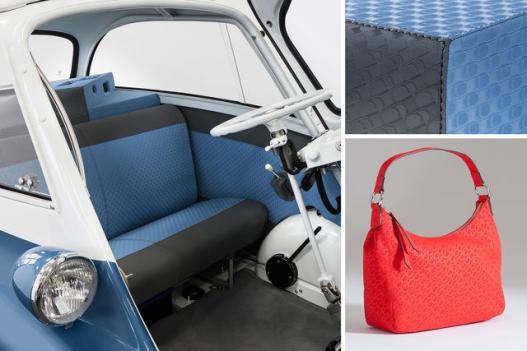Jul 6 2013
A few years ago, BASF created completely new ways to give surfaces an extremely unusual look and feel through use of a polyurethane dispersion with the brand name Steron®.
 A few years ago, BASF created completely new ways to give surfaces an extremely unusual look and feel through use of a polyurethane dispersion with the brand name Steron. Now, the company has automated the technology and is launching the first production applications in the automotive and furniture industries. The coating system combines the characteristics of leather, artificial leather, fabric and soft-touch materials. (Photo: BASF - The Chemical Company, 2013)
A few years ago, BASF created completely new ways to give surfaces an extremely unusual look and feel through use of a polyurethane dispersion with the brand name Steron. Now, the company has automated the technology and is launching the first production applications in the automotive and furniture industries. The coating system combines the characteristics of leather, artificial leather, fabric and soft-touch materials. (Photo: BASF - The Chemical Company, 2013)
The coating system combines the different characteristics of leather, artificial leather, fabric and soft-touch materials. It permits creation of surfaces with a structure and design that at present cannot be achieved in any other way. Now, BASF has automated the technology, joined with partners and is launching the first production applications in the automotive and furniture industries.
Versatile coating material
Steron can be used on a wide variety of substrates. For instance, leather and fabric as well as cardboard, paper and plastics such as PVC and polyurethane can serve as the substrate material. Moreover, the design freedom is almost limitless – regardless of whether technical, natural or soft-touch structures are involved. Quick design changes present no difficulties. Textures from leather graining to the appearance of velvet and even geometric patterns and impressions can be achieved with minimum effort. Finally, coating in any color is possible.
New production technology
Production of Steron is based on the transfer process. The process was refined over the past two years and has now been automated. The starting point for production is a silicone mold half into which the desired surface structure is engraved by a laser. A thin layer of the polyurethane dispersion is sprayed onto this surface in a manner similar to the technique used when working with a casting mold and assumes the desired shape. This top coat is followed by a base coat and then the adhesive. Finally, the substrate is laminated to the adhesive layer and the two are pressed together. Following this, the finished product can be removed from the mold. Modern laser technology permits fast and economical production of molds with any custom design. The benefit of silicone as the mold material is that it can be engraved readily by means of a laser, while the substrate with the Steron coating releases easily. The polyurethane dispersion is microporous and, in contrast to conventional leather finishes, can breathe, improving the comfort of the coated materials.
Steron in concept cars and future production applications
Thanks to its many characteristics and very wide design spectrum, Steron is ideal for use in many fields. In the case of automotive applications, leather and plastic serve as the substrate material. New design structures can be developed for seats, headrests, steering wheels and interior surfaces – with a smooth, soft or velvetlike feel as desired by the customer. Steron complements the trend toward creating a sense of well-being when seated in a car, i.e. the increasing demand for more comfort. Designers of concept cars have been inspired by the new options. For instance, the new coating is used in seat covers in the smart forvision and in side panels for the new Hyundai models HED-7 and Ioniq with laminated parts for seats and vehicle interior components. The automotive industry is now also showing great interest in the possibilities and benefits of Steron for high-volume production. Another aspect that is important for automakers looking to save every kilogram is the fact that the material is very light. Thus, compared to leather, which accounts for up to 25 kg in every vehicle, weight savings of more than 50% are possible.
For handbags, furniture and packaging – air-permeable, scratch-resistant and dirt-repellent
In addition to the automotive sector, there are many other possible fields of application for Steron where the principle of "one look – one touch" applies: Different products, but the same look and the same feel. The possibilities for clothing articles are also enormous. Substrate materials here include fabrics, plastic film and leather. Steron-coated leather in particular has the benefit of being completely air permeable. The unique soft touch is likely to find great interest among fashion designers and their customers for accessories such as hats, gloves, belts, wallets and handbags. Manufacturers of handbags will surely profit from the BASF product: A renowned fashion design house recently decided to use the new material, because it is lighter and less expensive than leather. The first handbags made from Steron are expected to be available in stores as of the fourth quarter of 2013. Finishing and labeling are problem-free and make the accessories even snazzier. Compared to Steron, for instance, conventional soft-touch products limit design possibilities, since they can be printed, embossed or laser-engraved only with difficulty or not at all. As for clothing, Steron opens up new opportunities for a wide mix of materials and designs for shoes. Here, too, substrate materials can be leather, fabric and synthetics.
In conjunction with leather, the Steron system has special characteristics that improve functionality of furniture – specifically, scratch resistance and dirt repellency in addition to air permeability. Moreover, the coating technology offers completely new design opportunities for high-quality packaging, where new patterns and previously unknown sensory effects can be expected.